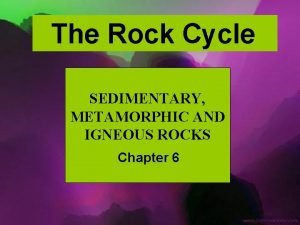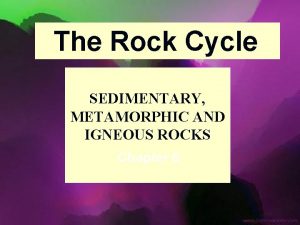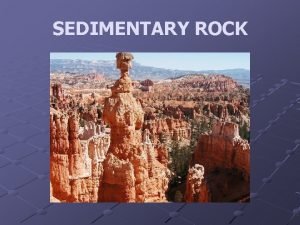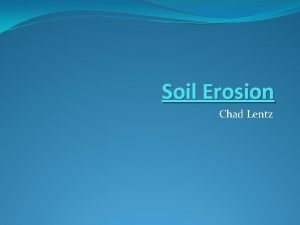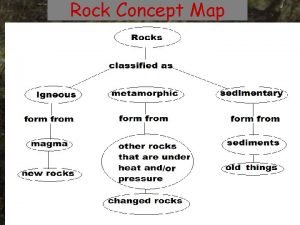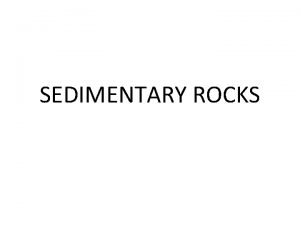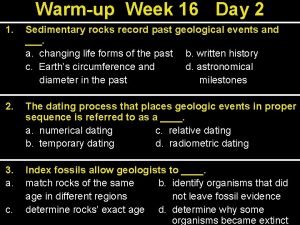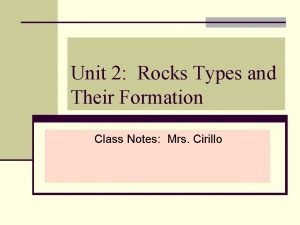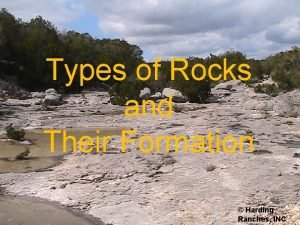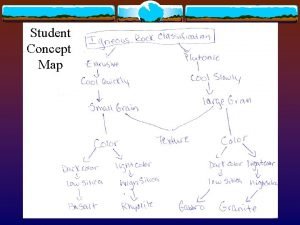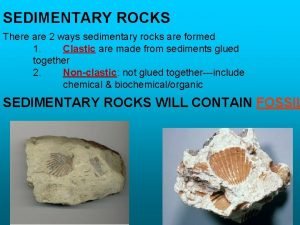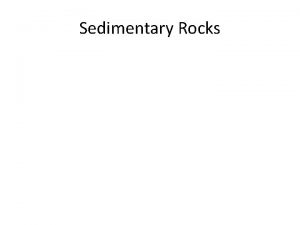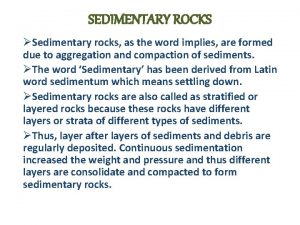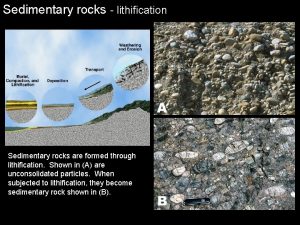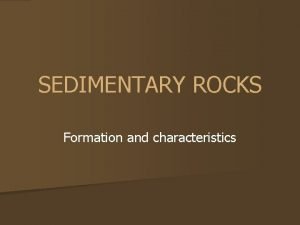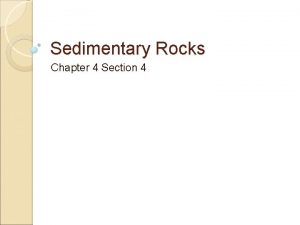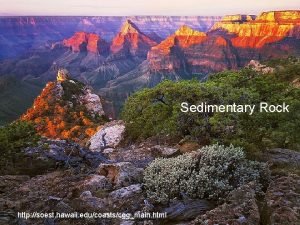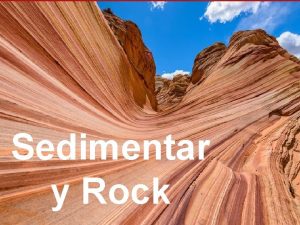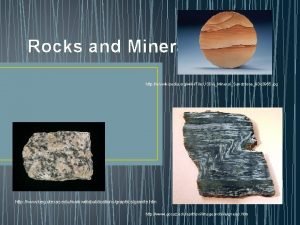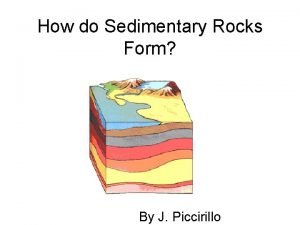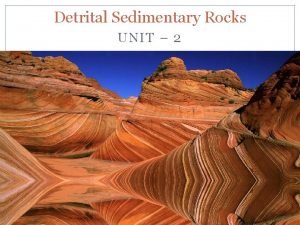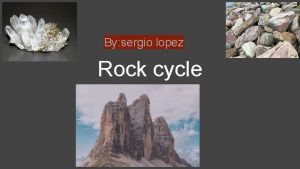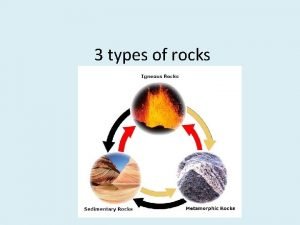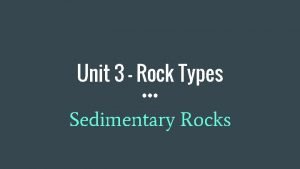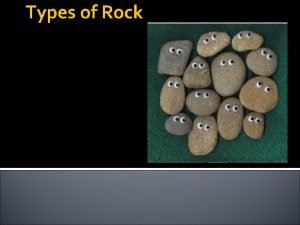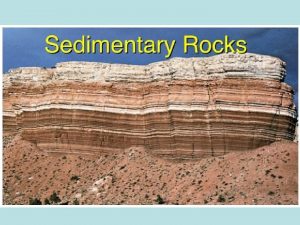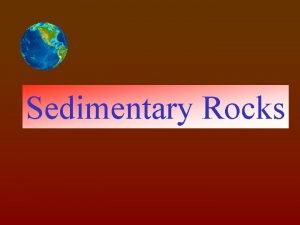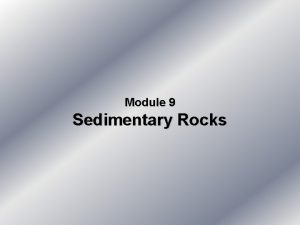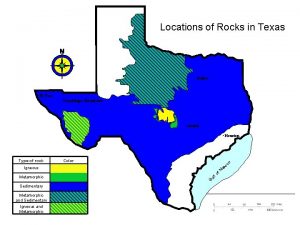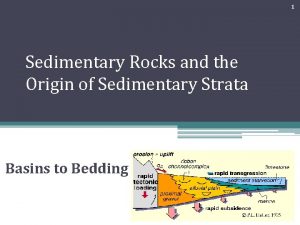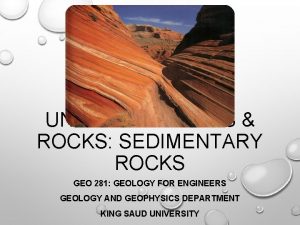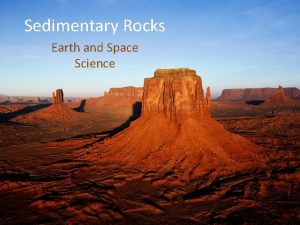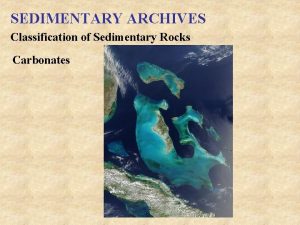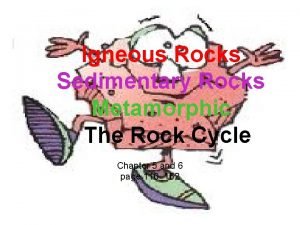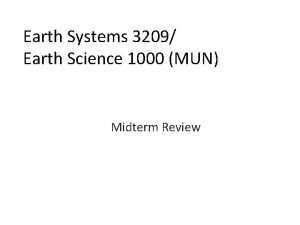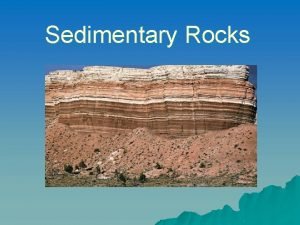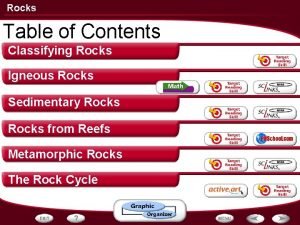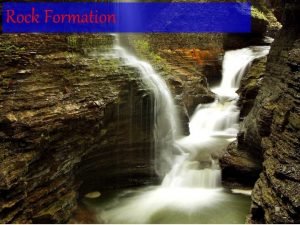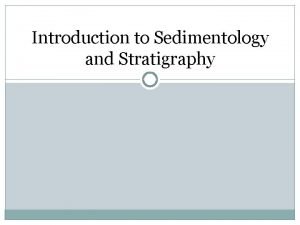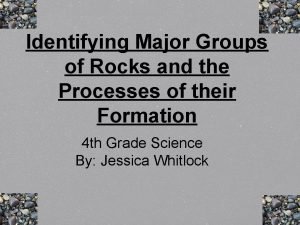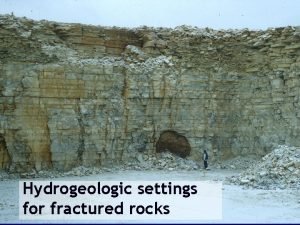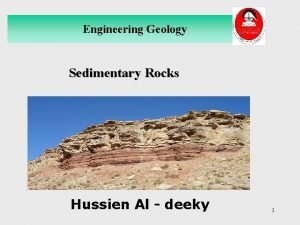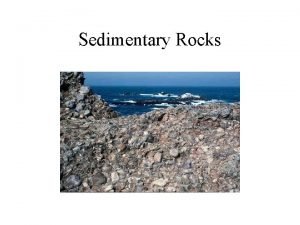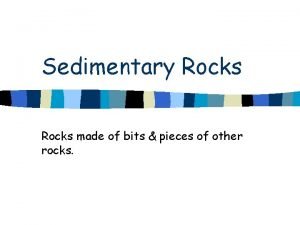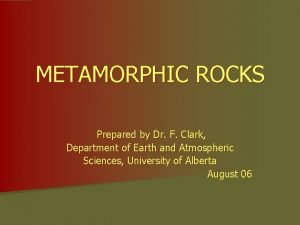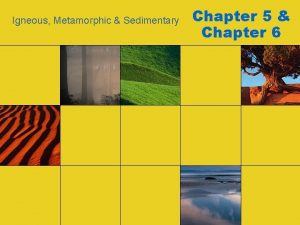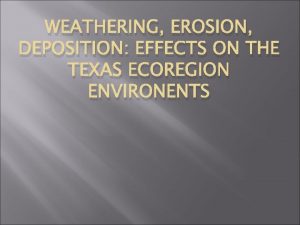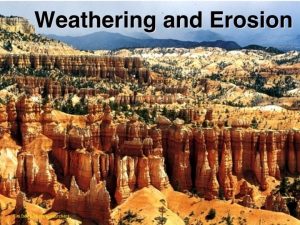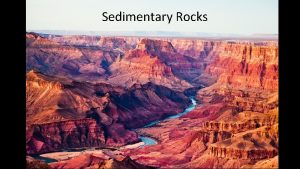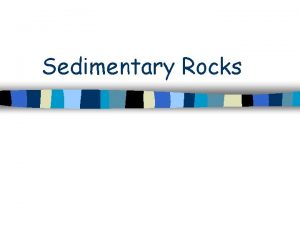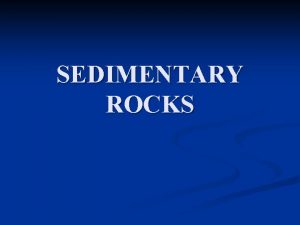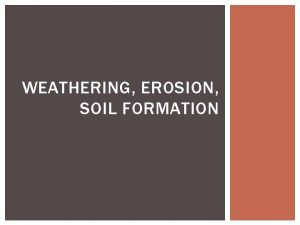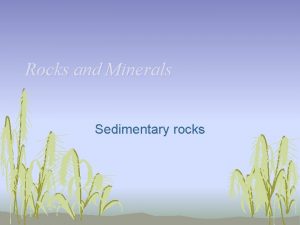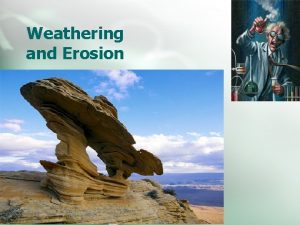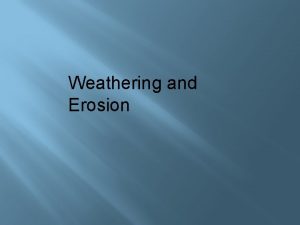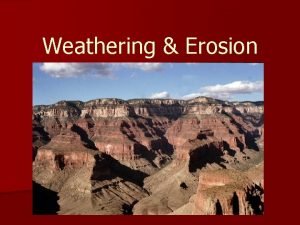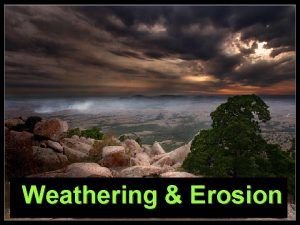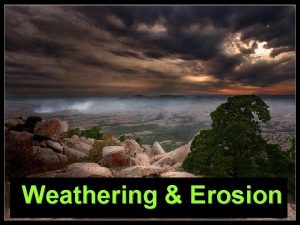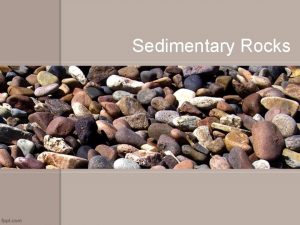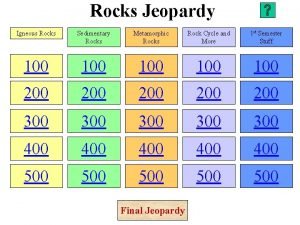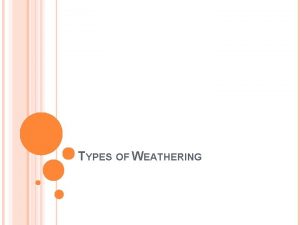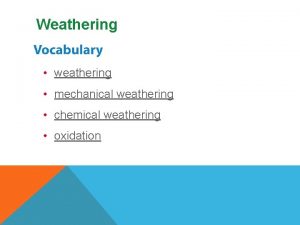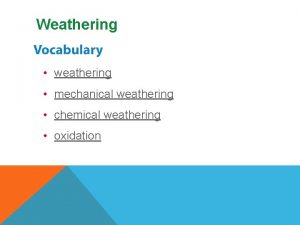Weathering and Erosion Formation of Sedimentary Rocks Weathering




































































- Slides: 68

Weathering and Erosion Formation of Sedimentary Rocks • Weathering – the physical breakdown (disintegration) and chemical alteration (decomposition) of rock at or near Earth’s surface • Erosion – the physical removal of material by agents such as water, wind, ice, or gravity

Sediment: weathered material derived from pre-existing rocks Sedimentary rock: consolidated sediment (compacted, cemented) plus fossils

Clastic sediments seen during fieldtrip

Clastic sedimentary rocks seen during fieldtrip

insoluable

basalt (Mg, Fe)2 Si. O 4 (Mg, Fe)Si. O 3 pyroxine H 4 Si. O 4 in solution Mg 2+ in solution Fe (III) hydroxide (insoluble, rust) Ca. Al 2 Si 2 O 8 Ca-feldspar and Na. Al. Si 3 O 8 Na-Feldspar Ca+2 in solution Na+1 in solution Al 2 Si 2 O 5(OH)4 (insoluble, “clay”)

granite Si. O 2 quartz Si. O 2 (insoluble, “sand”) Ca. Al 2 Si 2 O 8 Ca-feldspar; Na. Al. Si 3 O 8 Na-Feldspar KAl. Si 3 O 8 K-Feldspar Ca+2 , Na+1, K+1 in solution Al 2 Si 2 O 5(OH)4 (insoluble, “clay”) (Ca, Na)2(Mg, Fe, Al)5(Al, Si)8 O 22(OH)2 amphibole (and also mica) Mg+2, Ca+2 , Na+1 in solution Al 2 Si 2 O 5(OH)4 (insoluble, “clay”) Fe (III) hydroxide (insoluble, rust)

in quartz sand in clay in rust River sediments are consistent with the composition of the continental crust

Effect of surface area on weathering

Climate and Weathering

Hot and wet favors chemical weathering

Cold and snowy favors mechanial weathering

Why erosion is important • • Life in the sea depends on it to supply critical nutrients. It is responsible for the salt content of the sea. It is the source of the basic materials to form sedimentary rocks. It continually reduces and shapes the surface of the land.

Sea water Where’s the Cl come from? Why no silica?

Mechanisms of Erosion

Mass Wasting The often catastrophic (geologically rapid) movement of material on the Earth’s surface is referred to as mass wasting. Such features constitute the most widespread of the natural geological hazards. the Slumgullion earthflow/landslide, Hinsdale County, CO

Nevado Huascaran, Peru, 1970 It began high in the mountains as an earthquake-induced avalanche of snow and ice, but picked up glacial sediment on its way. It hit the towns of Yungay and Ranrahirca, 18 km away, at around 150 km/hr. The former town was completely buried. An astounding 66, 000 people were estimated dead as a result of this massive debris avalanche.

Mudslides: Costa Rica, June, 2000 The June 27 slide killed 10. Six were killed in the same place in 1993 mudslides.

landslides This is a typical landslide. Note that materials hold together in more-or-less singular blocks. As is common, when the slide blocks reach a lower slope, they break up (becoming a debris flow in this case). The La Conchita landslide, near Santa Barbara, CA, Spring, 1995.

Glaciers (mechanical) weathering

Freezing action

Freezing action

Frost wedging

Joint-controlled weathering

Roots (mechanical) weathering

Root Wedging

Chemical Weathering

Chemical Weathering

Differential Weathering and Erosion creates topography Slowly weathered and eroded - high (Morningside Heights, Palisades, Ramapo Mountains) Quickly weathered and eroded - low (sediments beneath Hudson River and west of Palisades)

Differential Weathering

Differential Weathering

Differential Weathering

Differential Weathering

Differential Weathering

Resistant cap rock

Clastic Sediments from “clast” … little piece Can be associated with rivers, glaciers, wind


Clastic Sediments and Clastic Sedimentary Rocks A. Sediments B. Sedimentary Rocks

Energy and Depositional Environment

Coarse-Grained Sediments Breccias Conglomerates

Tillite Brian J. Skinner

Worldwide sediment yield of major drainage basins

Where erosion occurs … elevation a factor … higher more erosion

Meaning of rate 100 tons per sq km per year 00 m 10 1000 meters 100 tons Rock density about 2. 5 tons per cubic meter so 100 tons is about 40 cubic meters (a cube 3. 4 m on edge) 1 sq km is 1, 000 sq meters Spread 40 cu meters over 1, 000 sq meters and get a layer 40/1, 000 = 0. 00004 meters = 0. 04 millimeters thick So in 100 years, wear away 4 mm

Rivers and Sediments

crossbed from fieldtrip Migration of meanders leads to cross-bedding

Deltas

Cross-section of Delta note that delta grows (progrades) towards sea

Hjulstrom Curve

Hjulstrom Curve Pebbles and cobbles: hard to get moving, an hard to keep moving Pebbles and cobbles

Hjulstrom Curve Sand: easy to get moving, a fairly easy to keep moving

Hjulstrom Curve Silt and Clay: hard to get moving, but very easy to keep moving

Human Influence • Human beings move more sediment through mining and building than rivers do. • Agricultural practices also increase erosion in rivers. Rates thousands of years ago were less than today. • Empounded water from lakes behind dams also prevent sediment from reaching the sea.

Existence of Lakes • Largely due to glaciation disrupting drainage networks. • North American lakes mostly at latitudes greater than 45°, where glaciers were during Pleistocene. • Will slowly fill up with sediment and disappear

Removal from sea water • Particles settle and are deposited as sediment. – Sedimentary rocks consisting of fine-grained particles (<. 06 mm) are called shale. – Sedimentary rocks made of medium-grained particles (. 06 -2 mm) are called sandstone. – Sedimentary rocks consisting of coarse-grained particles (> 2 mm) are called. conglomerates. • Calcium and bicarbonate are removed from seawater by organisms to form shells made of Ca. CO 3 (limestone). • Si. O 4 is removed from solution by organisms to form silica “ooze” which lithifies to chert (arrowheads). • Mg++ and SO 4 -- are removed from ocean water as that water is heated and pumped through mid-oceanic ridges. • Na+, K+, and Cl- are removed from seawater sporadically in evaporite deposits.

Formation of sedimentary rocks Cementation of grains by Ca. CO 3 or Si. O 2. • Names of clastic rocks depend on size of grains (big to small). – Conglomerates - tend to be poorly sorted. – Sandstones - often well-sorted. – Shales - made of clay minerals. • Non-clastic rocks: from dissolved load – Limestones - Ca. CO 3, usually removed from water by a biological process (e. g. corals and sea-shells). – Evaporites - Na. Cl and Ca. SO 4 from evaporation of seawater in enclosed basins (e. g. Utah's Great Salt Lake and the Mid-East's Dead Sea).

Shale Formation

Bioclastic Limestone

Fine-Grained Limestone Deep sea limestones will not have visible fossils, because they are made up of the shells of little dead bugs like these: foraminifera. This specimen (viewed by scanning electron microscope) is about 100 microns long (0. 1 millimeter).

Coccoliths – another type of organisms with a Ca. CO 3 test

Chert Some microorganisms secrete silica shells. When these pile up on the deep ocean floor, they lithify to become a micro-crystalline quartz rock called chert (the same stuff as the substance flint). diatoms and radiolaria

Diatoms – organisms with silica tests

Radiolaria – another silica test

Chert arrowhead

Chert beds, now deformed Near Golden Gate Bridge

Evaporites Calcite, halite and gypsum are common precipitates from dried lakes in arid environments. the white is halite, the red are bacteria that love salt Owens Valley, CA

Evaporites in Death Valley Martin G. Miller

 Igneous vs sedimentary or metamorphic
Igneous vs sedimentary or metamorphic Igneous metamorphic and sedimentary
Igneous metamorphic and sedimentary Sedimentary weathering
Sedimentary weathering Sedimentary rock formation
Sedimentary rock formation Soil types in ireland
Soil types in ireland Control measures of soil erosion
Control measures of soil erosion Sedimentary and metamorphic rocks chapter 6
Sedimentary and metamorphic rocks chapter 6 Concept map for igneous rock
Concept map for igneous rock Detrital
Detrital Parent the rock
Parent the rock Sedimentary rocks record past geological events and ____.
Sedimentary rocks record past geological events and ____. Esrt sedimentary rocks
Esrt sedimentary rocks Sedimentary rocks examples
Sedimentary rocks examples Igneous rocks concept map
Igneous rocks concept map Sedimentary rocks
Sedimentary rocks Rocks formation
Rocks formation Define bioclastic
Define bioclastic Characteristics of sedimentary rocks
Characteristics of sedimentary rocks What are sedimentary rocks
What are sedimentary rocks In sedimentary rocks lithification includes
In sedimentary rocks lithification includes Sedimentary rocks characteristics
Sedimentary rocks characteristics Cementation sedimentary rocks
Cementation sedimentary rocks Sorting sedimentary rocks
Sorting sedimentary rocks Sedimentary rocks examples
Sedimentary rocks examples Soest hawaii
Soest hawaii Fun facts about sedimentary rocks
Fun facts about sedimentary rocks Esrt sedimentary rocks
Esrt sedimentary rocks Sedimentary rock characteristics
Sedimentary rock characteristics Classify sedimentary rocks
Classify sedimentary rocks Esrt sedimentary rocks
Esrt sedimentary rocks Biochemical sedimentary rocks
Biochemical sedimentary rocks Sedimentary rocks
Sedimentary rocks Attritiom
Attritiom Facts on sedimentary rocks
Facts on sedimentary rocks Rocks formation
Rocks formation Biochemical sedimentary rocks
Biochemical sedimentary rocks Coarse grained rocks examples
Coarse grained rocks examples How do the rocks stick together to undergo lithification?
How do the rocks stick together to undergo lithification? Organic sedimentary rocks
Organic sedimentary rocks Sandstone
Sandstone Clastic sedimentary rocks
Clastic sedimentary rocks Organic sedimentary rocks
Organic sedimentary rocks Metamorphic rocks in texas
Metamorphic rocks in texas Allochemical sedimentary rocks
Allochemical sedimentary rocks Chemical sedimentary rocks formed
Chemical sedimentary rocks formed Rock chart
Rock chart Sedimentary rocks
Sedimentary rocks How are sedimentary rocks formed
How are sedimentary rocks formed Rock cycle outline
Rock cycle outline Silicon oxygen tetrahedron
Silicon oxygen tetrahedron How are sedimentary rocks formed
How are sedimentary rocks formed How are sedimentary rocks made
How are sedimentary rocks made Igneous rocks
Igneous rocks Properties of sedimentary rocks
Properties of sedimentary rocks Mechanically formed sedimentary rocks
Mechanically formed sedimentary rocks Sedimentary rocks turn into metamorphic
Sedimentary rocks turn into metamorphic Sedimentary rocks
Sedimentary rocks Importance of metamorphic rocks to man
Importance of metamorphic rocks to man Sedimentary rock
Sedimentary rock Ripple marks
Ripple marks How do chemical sedimentary rocks form
How do chemical sedimentary rocks form Characteristics of sedimentary rocks
Characteristics of sedimentary rocks Sedimentary rocks
Sedimentary rocks Fossils in sedimentary rocks
Fossils in sedimentary rocks Green sedimentary rocks
Green sedimentary rocks Landslides moving water wind and glaciers cause
Landslides moving water wind and glaciers cause Sedimentary rocks
Sedimentary rocks How does weathering affect edwards plateau
How does weathering affect edwards plateau Erosion
Erosion
